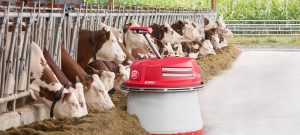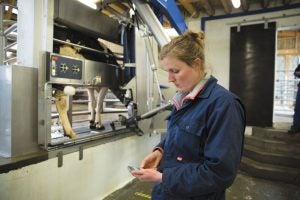Advancements in technology allow producers to keep their animals healthier and happier than even a generation ago
Farmers today do more with less. They produce more crop on less land. They raise more animals with fewer resources. Cows can be milked with robots. But what does all this mean for animal welfare? Does it put more stress on them?
It’s a great question that I hear all the time, but the short answer is no. Let’s take dairy cows for example. My friend, Kim Bremmer, was a dairy nutritionist for over 15 years and has a degree in dairy science from University of Wisconsin-Madison, where she emphasizes the Cow Comfort Consortium and work of Dr. Nigel Cook.

“Cows eat better than people!” is a popular expression for Bremmer, where she explains the fact that cows eat about a dozen (9 to 14 to be exact) times per day with a diet that consists of over 60 nutrients down to very specific amino acids. “If cows are stressed, they won’t produce milk. Cows are upcyclers, and the research behind their nutrition and comfort is amazing.”
“Cows produce more milk today than ever before for two main reasons,” adds Bremmer:
- 1. Genetics
- 2. Overall animal care
Most cows nowadays are bred through artificial insemination for many reasons explained here. You look at the book and select the best studs to achieve the best results for genomics and health traits for the cows and calves. In terms of animal health and care, this link explains the top six key comfort and housing parameters.
Comfort, comfort, comfort.
“We study the time budget and know that we want cows laying down 12 to 14 hours per day,” says Bremmer. “When cows are laying down, it improves circulation to the udder, which allows cows to produce more milk.” Farmers adjust ventilation, heating/cooling, bedding, stall styles (like freestall barns) and dimensions, and the height of neck rails, among other things, to make sure the animals are the most comfortable they can be. Sand bedding tends to be the best for the cows, as it is the cleanest and doesn’t harbor bacteria; however it does come with its challenges, particularly when it doesn’t work with all manure management systems. (Thankfully, there are many options.)

Dairy research stems primarily from feed companies and universities where they study very specific feed aspects, such as protein or fiber. They measure how often cows rest, eat, drink, stand, etc. Robotic milking systems, what’s offered by Lely or DeLaval, for example, can track scores of behavior data points on a cow, like how often she chews her cud, how many steps she takes, how much she eats and how much milk she produces. This also helps farmers and veterinarians track exactly when and where an animal needs their attention.
Adds Bremmer, “When you minimize stress on animals and study cow comfort and handling, you get tremendous results. We didn’t use to feed cows like this; they eat better than they did on Grandpa’s farm. And my grandpa was a good farmer. We are learning and utilizing science and research to improve animal care now more than ever.”
Yes, today’s farms do more with less. And that’s good for the animals, too, while we keep making their lives better.
Michelle Miller, the Farm Babe, is an Iowa-based farmer, public speaker, and writer, who lives and works with her boyfriend on their farm, which consists of row crops, beef cattle, and sheep. She believes education is key in bridging the gap between farmers and consumers.



